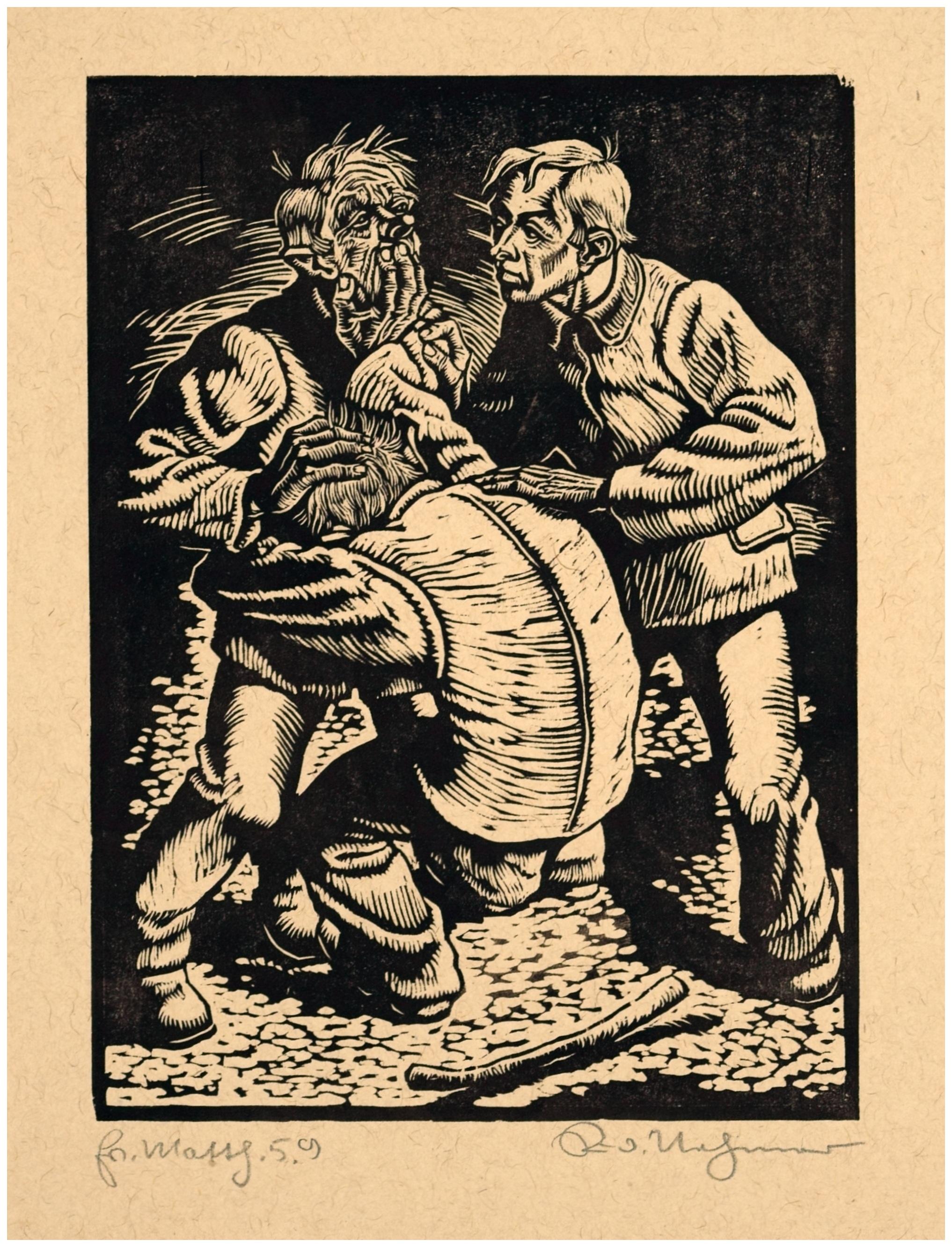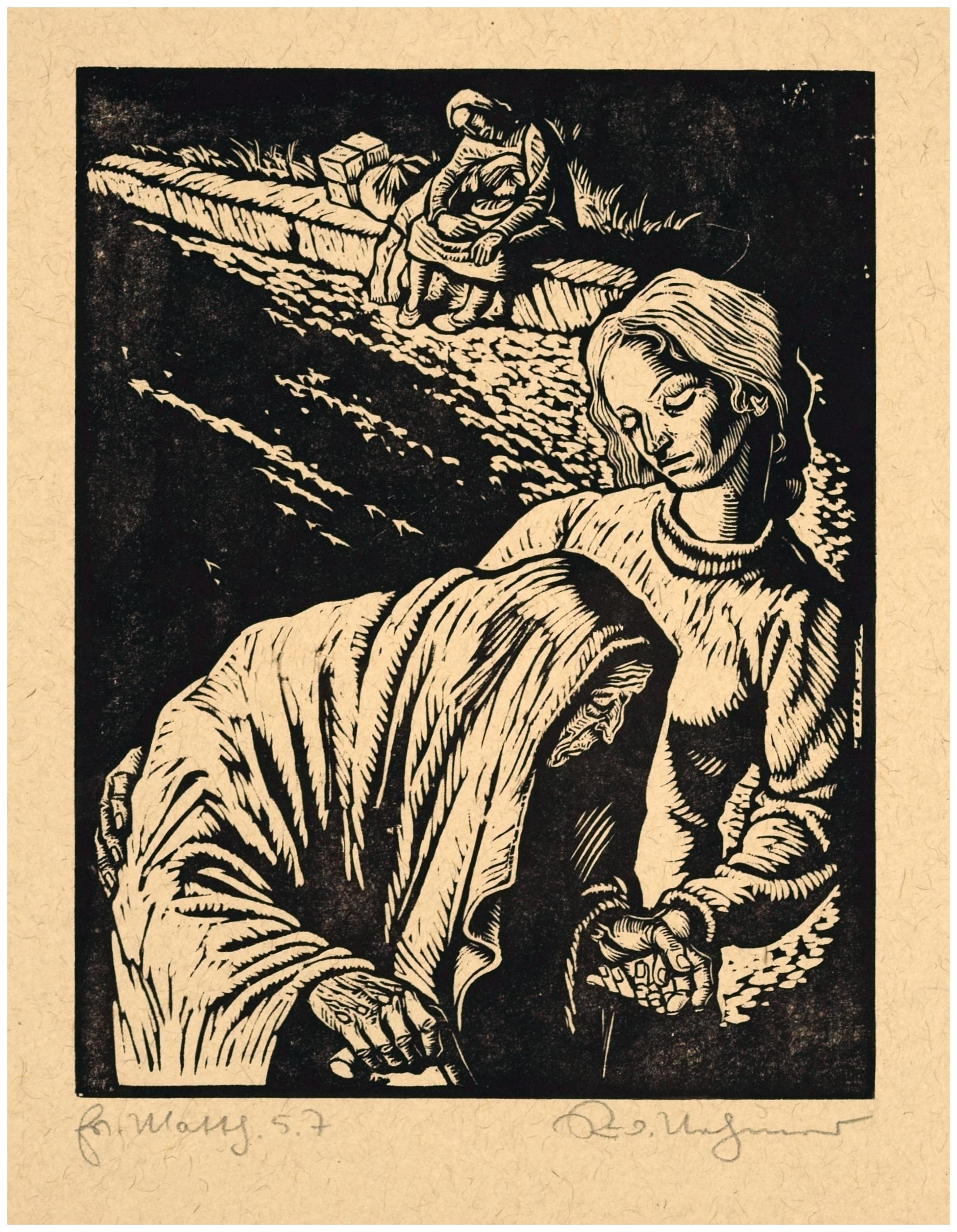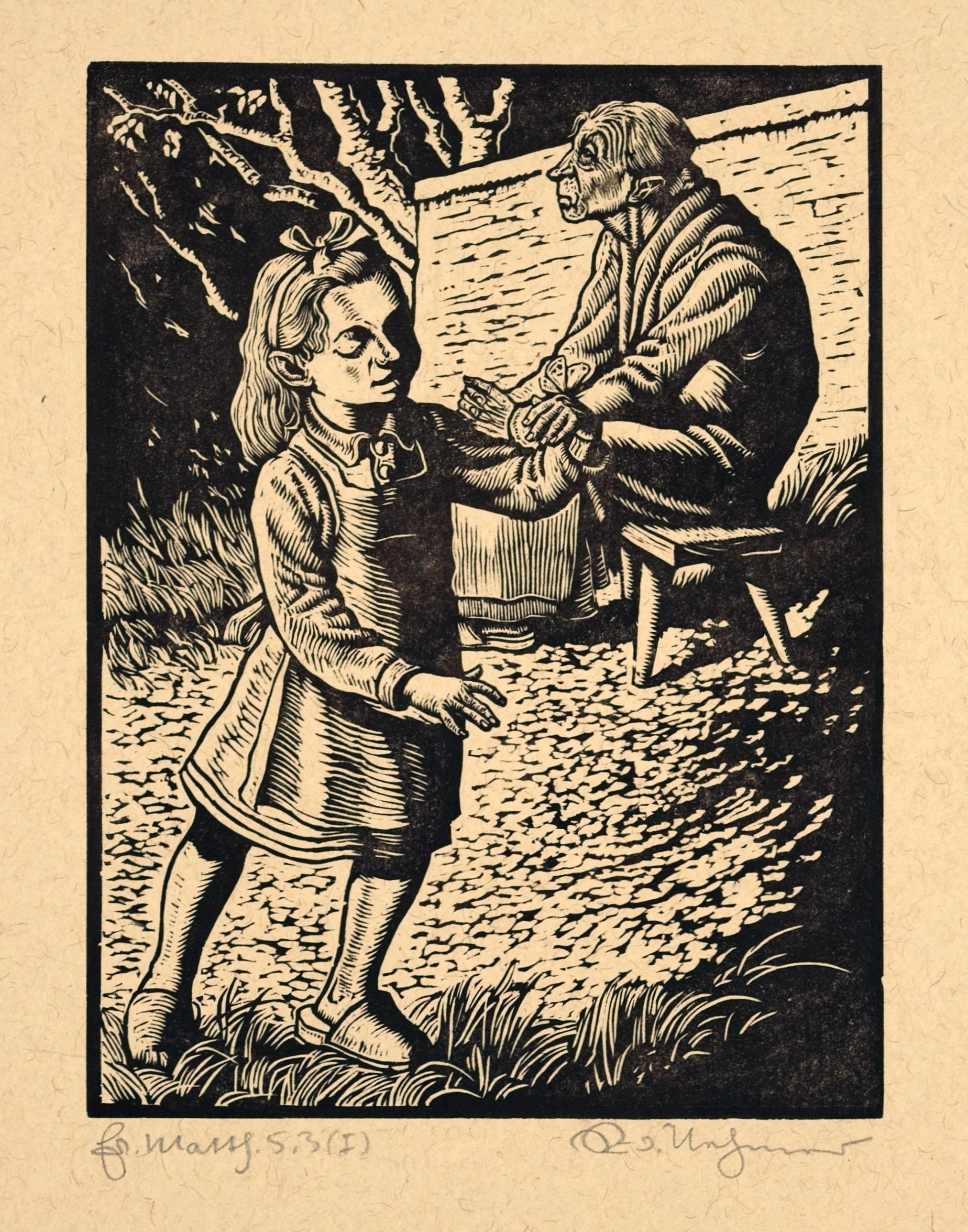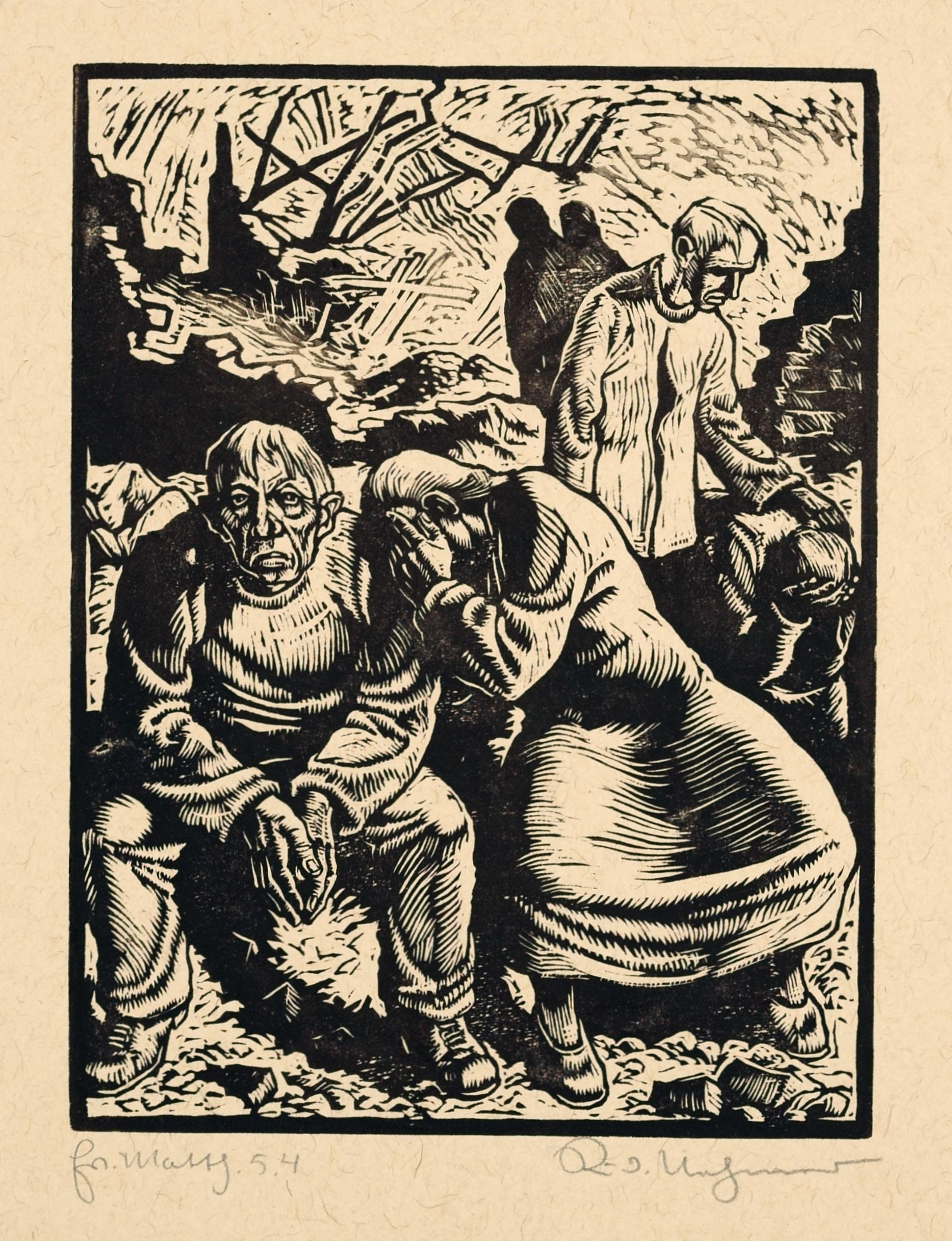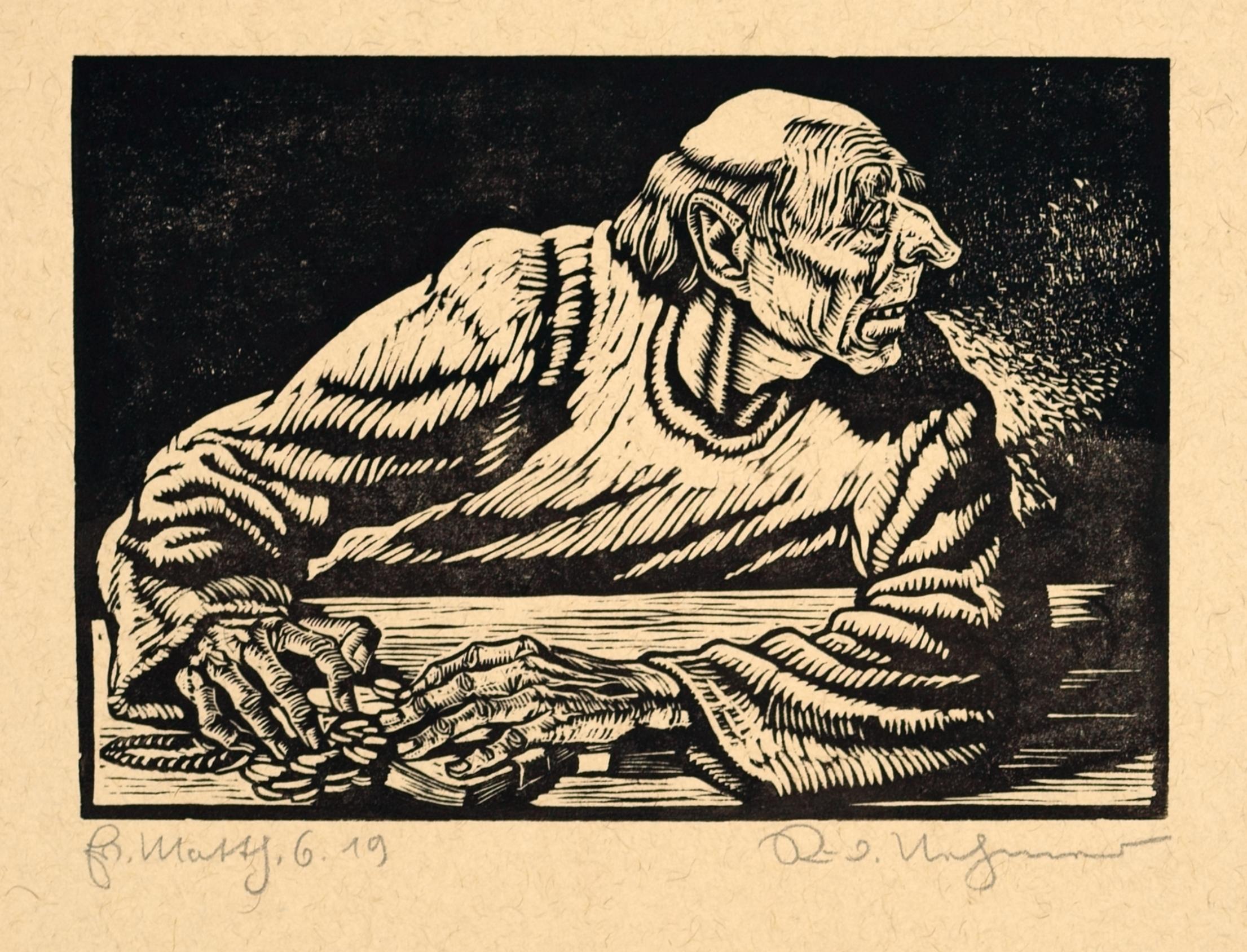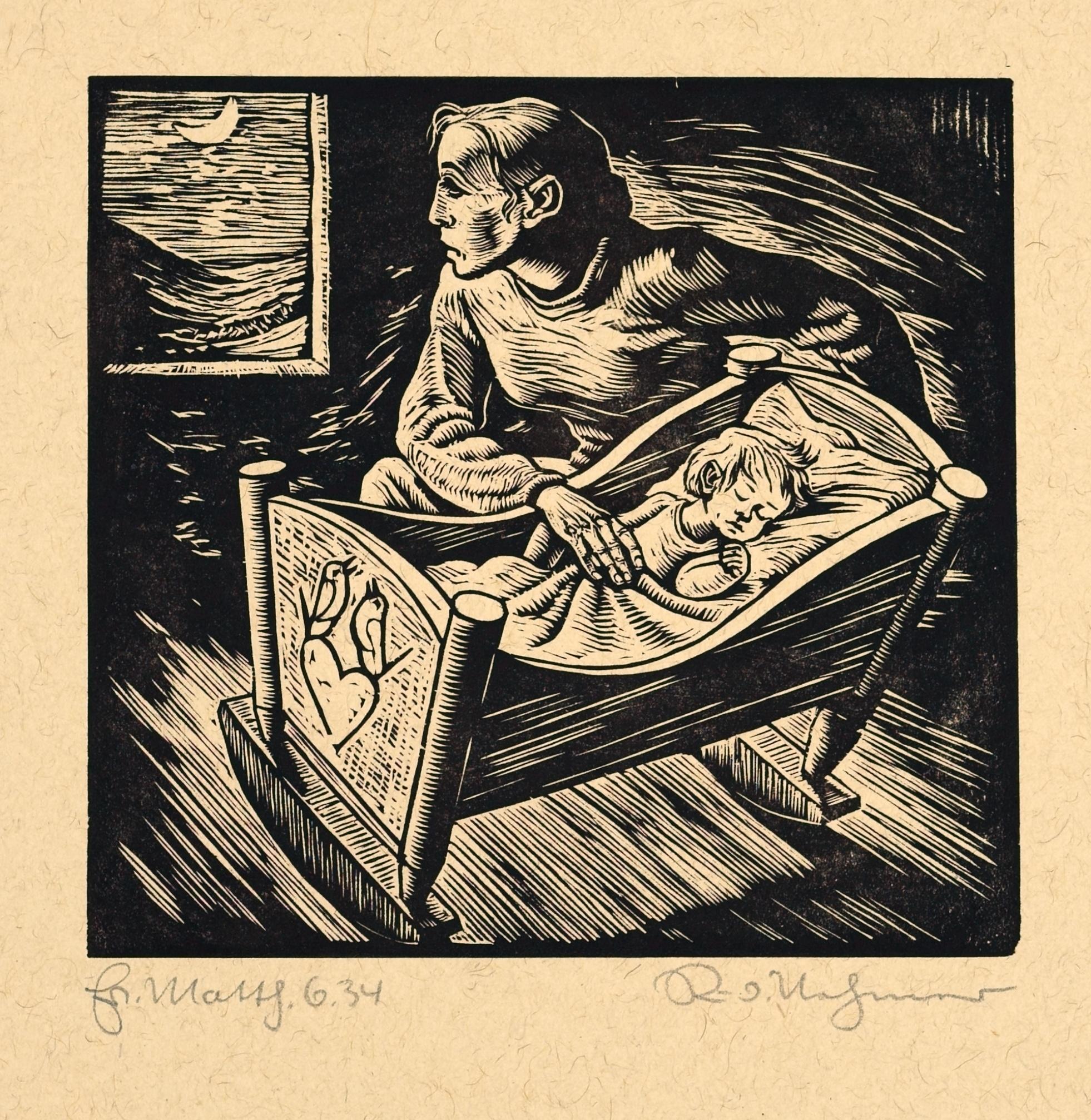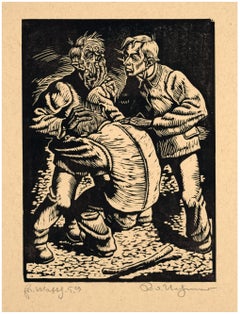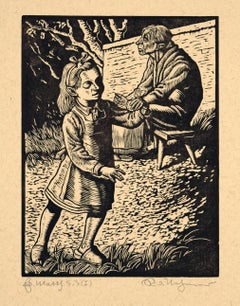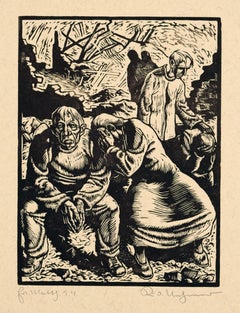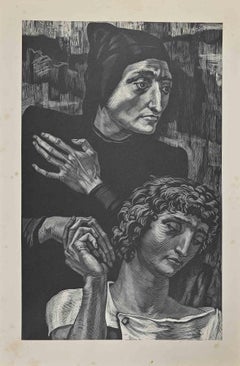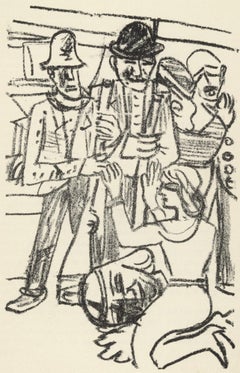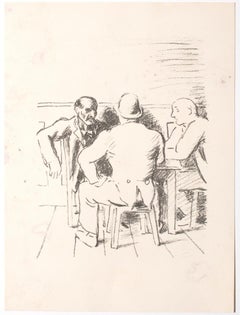Items Similar to The Reconciliation / - Togetherness -
Want more images or videos?
Request additional images or videos from the seller
1 of 8
Rudolf NehmerThe Reconciliation / - Togetherness -1948
1948
$170.72
$213.4020% Off
£129.73
£162.1620% Off
€144
€18020% Off
CA$239.58
CA$299.4720% Off
A$261.24
A$326.5520% Off
CHF 135.78
CHF 169.7220% Off
MX$3,127.36
MX$3,909.2020% Off
NOK 1,722.21
NOK 2,152.7620% Off
SEK 1,613.17
SEK 2,016.4620% Off
DKK 1,097
DKK 1,371.2520% Off
About the Item
Rudolf Nehmer (1912 Bobersberg - 1983 Dresden), The Reconciliation, 1948. Woodcut on yellowish wove paper, 20 cm x 15 cm (image), 45 cm x 30 cm (sheet size), signed “Rud.[olf] Nehmer” in pencil lower right and inscribed “Matth. 5,24” lower left.
- The wide sheet margin somewhat wavy in places, the image in excellent, vibrant condition.
- Togetherness -
This woodcut is part of Nehmer's best-known series, his pictorial interpretation of the Sermon on the Mount (Matth. 5:1-7:29), created shortly after the end of World War II. The print illustrates the verse: When you offer your gift at the altar, if you remember that your brother has something against you, leave your gift there before the altar, and go and be reconciled to your brother, and then come and offer your gift (Matthew 5:24).
With the hand on the heart, the reconciliation offered with the arm is accepted with emotion and sealed with a handshake. The former adversaries look into each other's eyes, seemingly unable to understand why they had quarreled in the first place.
About the artist
Rudolf Nehmer studied from 1932 to 1934 in Dresden at the private art academy founded by Ernst Oskar Simonson-Castelli under Woldemar Winkler and, after a brief interlude at the art academy, was a student in Willy Kriegel's studio until 1936. After his first one-man show in 1935 at the Kühl Art Exhibition in Dresden, which was progressive until the Nazi era, Nehmer was represented at the major German art exhibitions in the following years. In 1938 he stayed in Worpswede. From 1941 he was a soldier on the Western Front and in Denmark, returning to Dresden from British captivity in 1945. After the war, he had his first solo exhibition in 1945. Nehmer was a co-founder of the artists' association 'Das Ufer - Gruppe 1947' and in 1951 a founding member of the artists' cooperative 'Kunst und Zeit'. He had numerous solo and group exhibitions in the GDR, culminating in a retrospective at the Galerie Neuer Meister on the occasion of his 60th birthday.
GERMAN VERSION
Rudolf Nehmer (1912 Bobersberg - 1983 Dresden), Die Versöhnung, 1948. Holzschnitt auf gelblichem Velin, 20 cm x 15 cm (Darstellung), 45 cm x 30 cm (Blattgröße), unten rechts in Blei mit „Rud.[olf] Nehmer“ signiert und unten links mit „Matth. 5,24“ bezeichnet.
- Der breite Blattrand teilweise etwas gewellt, die Darstellung in ausgezeichnetem farbkräftigem Zustand.
- Zweisamkeit -
Der Holzschnitt gehört zu Nehmers bekanntester Graphikfolge, seiner kurz nach dem Ende des Zweiten Weltkrieges geschaffenen bildlichen Auslegung der Bergpredigt (Matth. 5,1-7,29). Das Blatt veranschaulicht den Vers: Darum, wenn du deine Gabe auf dem Altar opferst und wirst allda eingedenk, daß dein Bruder etwas wider dich habe, so laß allda vor dem Altar deine Gabe und gehe zuvor hin und versöhne dich mit deinem Bruder, und alsdann komm und opfere deine Gabe (Matth. 5,24).
Mit einer Hand am Herz wird die mit dem Arm dargebotene Versöhnung voller Ergriffenheit angenommen und mit einem Handschlag besiegelt. Dabei schauen sich die ehemaligen Kontrahenten in die Augen und können offenbar selbst nicht mehr verstehen, warum es überhaupt zum Zerwürfnis kam.
zum Künstler
Rudolf Nehmer studierte von 1932 bis 1934 in Dresden an der von Ernst Oskar Simonson-Castelli gegründeten privaten Kunstakademie bei Woldemar Winkler und war – nach einem kurzen Intermezzo an der Kunstakademie – bis 1936 Schüler im Atelier von Willy Kriegel. Nach einer ersten Einzelausstellung im Jahre 1935 in der bis in die NS-Zeit hinein progressiven Dresdner Kunstausstellung Kühl, war Nehmer in den Folgejahren in den Großen Deutschen Kunstausstellungen vertreten. 1938 weilte er in Worpswede. Ab 1941 war er Soldat an der Westfront und in Dänemark und kehrte 1945 aus britischer Kriegsgefangenschaft nach Dresden zurück. Nach dem Kriegsende erfolgte bereits 1945 die erste Einzelausstellung. Nehmer war Mitbegründer der Künstlervereinigung ‚Das Ufer – Gruppe 1947‘ und war 1951 Gründungsmitglied der Künstlergenossenschaft ‚Kunst und Zeit‘. In der DDR erfolgten zahlreiche Einzelausstellungen und Ausstellungsbeteiligungen, die in einer Retrospektive anlässlich seines 60. Geburtstags in der Galerie Neuer Meister gipfelte.

About the Seller
5.0
Vetted Professional Seller
Every seller passes strict standards for authenticity and reliability
Established in 2014
1stDibs seller since 2023
22 sales on 1stDibs
Typical response time: <1 hour
- ShippingRetrieving quote...Shipping from: Berlin, Germany
- Return Policy
More From This Seller
View AllBlessed are the peacemakers / - Dehumanization -
Located in Berlin, DE
Rudolf Nehmer (1912 Bobersberg - 1983 Dresden), Blessed are the peacemakers, 1948. Woodcut on yellowish wove paper, 18 cm x 15.5 cm (image), 45 cm x 30 cm (sheet size), signed “Rud.[...
Category
1940s Realist Figurative Prints
Materials
Woodcut
$170 Sale Price
20% Off
Blessed are the merciful / - The support of care -
Located in Berlin, DE
Nehmer, Rudolf (1912-1983), Blessed are the merciful, 1948
Rudolf Nehmer (1912 Bobersberg - 1983 Dresden), Blessed are the merciful, 1948. Woodcut on yellowish wove paper, 18.8 cm x ...
Category
1940s Realist Figurative Prints
Materials
Woodcut
$180 Sale Price
20% Off
Blessed are the spiritually poor / - The Abundance of Poverty -
Located in Berlin, DE
Rudolf Nehmer (1912 Bobersberg - 1983 Dresden), Blessed are the spiritually poor, 1948. Woodcut on yellowish wove paper, 20 cm x 15 cm (image), 45 cm x 30 cm (sheet size), signed “Ru...
Category
1940s Realist Figurative Prints
Materials
Woodcut
$180 Sale Price
20% Off
The Zero Hour / - After the End of the World -
Located in Berlin, DE
Rudolf Nehmer (1912 Bobersberg - 1983 Dresden), The Zero Hour, 1948. Woodcut on yellowish wove paper, 20 cm x 14.8 cm (image), 43 cm x 30 cm (sheet size), signed “Rud.[olf] Nehmer” i...
Category
1940s Realist Figurative Prints
Materials
Woodcut
$265 Sale Price
20% Off
Greed / - The Poverty of Wealth -
Located in Berlin, DE
Rudolf Nehmer (1912 Bobersberg - 1983 Dresden), The birds under the sky, 1948. Woodcut on yellowish wove paper, 11 cm x 18 cm (depiction), 43 cm x 30 cm (sheet size), signed “Rud.[ol...
Category
1940s Realist Figurative Prints
Materials
Woodcut
$170 Sale Price
20% Off
The tilt of the day / - Suffering and Love -
Located in Berlin, DE
Rudolf Nehmer (1912 Bobersberg - 1983 Dresden), The tilt of the day, 1948. Woodcut on yellowish wove paper, 14.3 cm x 15 cm (image), 43 cm x 30 cm (sheet size), signed “Rud.[olf] Neh...
Category
1940s Realist Figurative Prints
Materials
Woodcut
$180 Sale Price
20% Off
You May Also Like
Isaac Friedlander, My People
By Isaac Friedlander
Located in New York, NY
Isaac (sometimes Isac) Friedlander's large wood engraving, My People, 1944, reflects his genuine social interest. After a youth of extreme hardship, including incarceration in a czar...
Category
1940s Expressionist Figurative Prints
Materials
Woodcut
The Compassion - Etching - Early 20th Century
By Albert Decaris
Located in Roma, IT
The Compassion is an etching realized by Albert Decaris in the Early 20th Century.
In good conditions with some foxing.
The artwork is presented through deft strokes, the expressi...
Category
Early 20th Century Modern Figurative Prints
Materials
Etching
Beckmann, Composition (Hofmaier 323-329), Der Mensch ist kein Haustier (after)
By Max Beckmann
Located in Southampton, NY
Lithograph on Van Gelder Zonen Bütten paper. Inscription: Unsigned and unnumbered, as issued. Good condition. Notes: From the volume, Der Mensch ist kein Haustier, 1937. Published by...
Category
1930s Modern Figurative Prints
Materials
Lithograph
$1,036 Sale Price
58% Off
Free Shipping
The Meeting - Original Lithograph - Mid-20th Century
Located in Roma, IT
The Meeting is an original lithography artwork on paper realized by Anonymous Artist in the mid-20th Century.
In good condition, with small foxing.
The artwork represents seated me...
Category
Mid-20th Century Modern Portrait Prints
Materials
Lithograph
Beckmann, Composition (Hofmaier 323-329), Der Mensch ist kein Haustier (after)
By Max Beckmann
Located in Southampton, NY
Lithograph on Van Gelder Zonen Bütten paper. Inscription: Unsigned and unnumbered, as issued. Good condition. Notes: From the volume, Der Mensch ist kein Haustier, 1937. Published by...
Category
1930s Modern Figurative Prints
Materials
Lithograph
$1,036 Sale Price
58% Off
Free Shipping
LOVERS (LIEBESPAAR
Located in Santa Monica, CA
ROBERT PHILIPPI (Austrian 1877-1959)
LIEBESPAAR (LOVERS) ca.1923 (in Rifkind Collection, LACMA: From a portfolio of 10 prints. Rifkind indicates the e...
Category
1920s Expressionist Figurative Prints
Materials
Woodcut
More Ways To Browse
Brian Clarke
Bruno Schulz
Caroline Durieux On Sale
Chagall Arabian Nights
Chagall In The Land Of Gods
Chagall Maternity
Chagall Paysage
Chagall Romeo
Chagall Ruth Gleaning
Chagall Signed Poster
Christ And The Rembrandt
Christian Silvain
Clemens Briels On Sale
Collier Picasso
Corneille Bleu
Cristina Martinez
Dali Alice In Wonderland
Dali Aliyah
